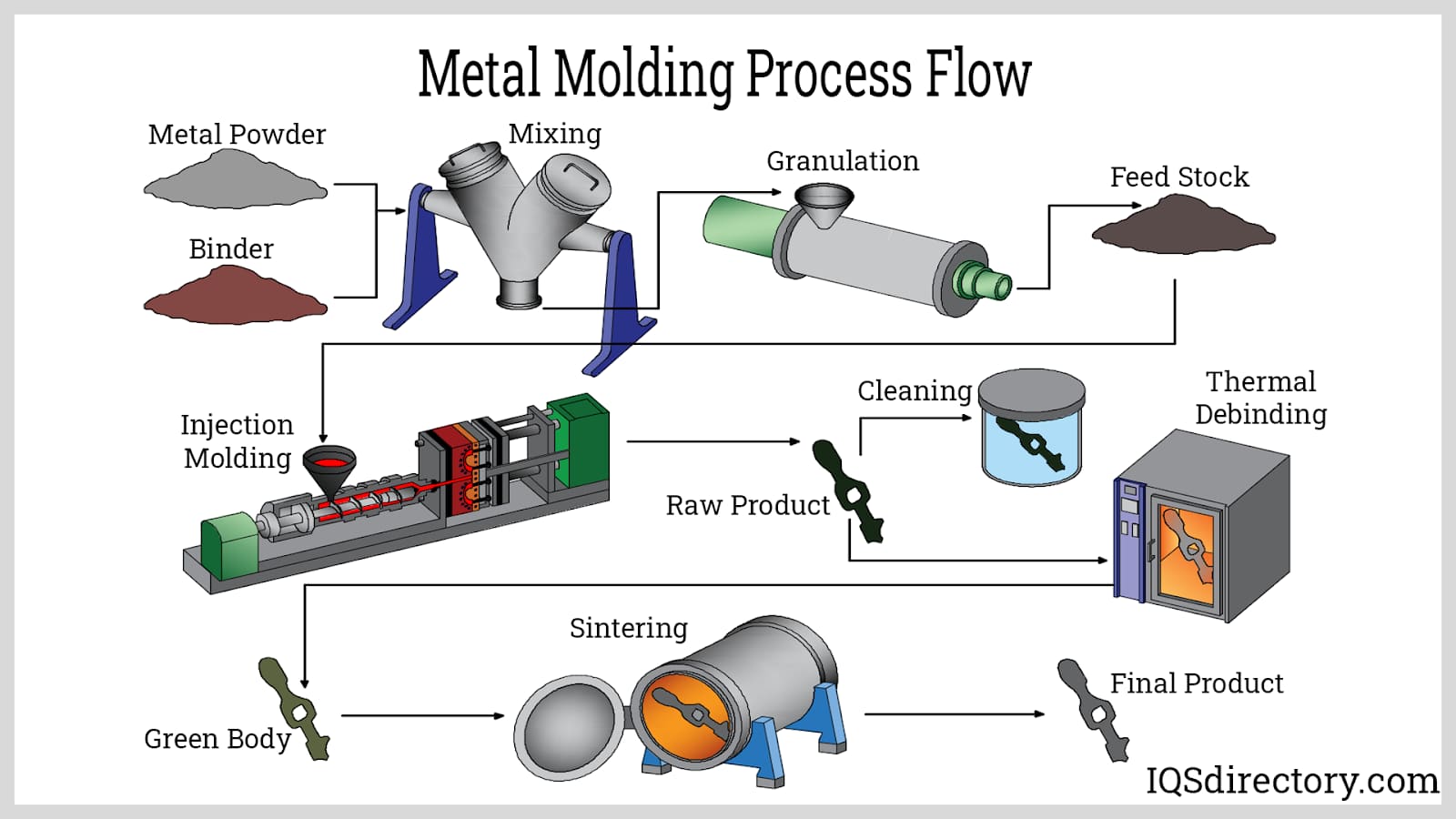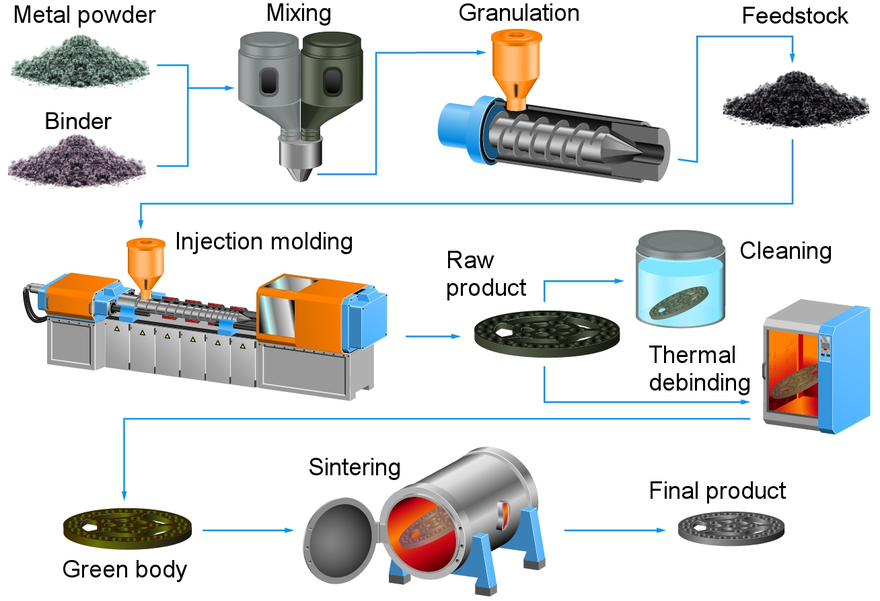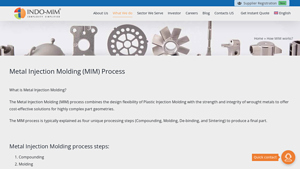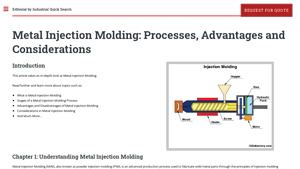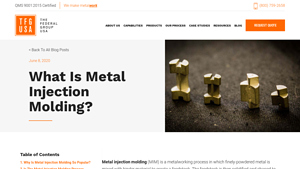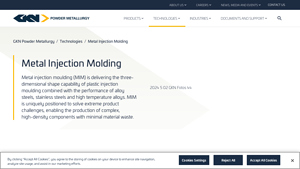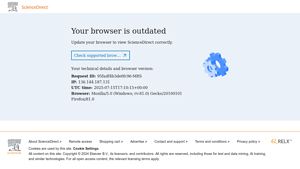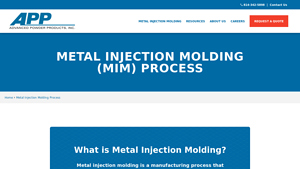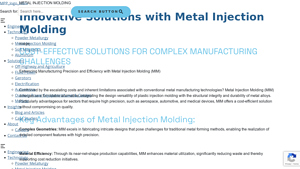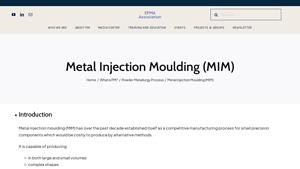Metal Injection Molding Process Guide: Type, Cost, Top List…
Introduction: Navigating the Global Market for metal injection molding process
In an increasingly competitive global market, sourcing efficient and cost-effective solutions for complex component manufacturing can be a daunting challenge for B2B buyers. The metal injection molding (MIM) process stands out as a powerful alternative to traditional manufacturing methods, offering unparalleled design flexibility and superior mechanical properties. This guide delves into the intricacies of metal injection molding, providing an exhaustive overview of various types, applications, and materials involved in the process.
From automotive parts to medical devices, MIM is revolutionizing production capabilities across multiple industries, particularly for small, intricate components that require high precision. Additionally, we’ll cover essential aspects of supplier vetting, cost considerations, and potential pitfalls to avoid during your sourcing journey.
International B2B buyers from regions such as Africa, South America, the Middle East, and Europe—including countries like Nigeria and Saudi Arabia—will find this guide invaluable. It empowers decision-makers with the insights needed to navigate the complexities of the MIM market, ensuring informed purchasing decisions that align with their unique operational needs and budget constraints. By leveraging the knowledge presented here, businesses can confidently engage with suppliers, optimize their production processes, and ultimately enhance their competitive edge in the global marketplace.
Understanding metal injection molding process Types and Variations
| Type Name | Key Distinguishing Features | Primary B2B Applications | Brief Pros & Cons for Buyers |
|---|---|---|---|
| Conventional MIM | Utilizes a blend of fine metal powder and thermoplastics; high precision and density. | Automotive, medical devices, consumer electronics | Pros: High complexity achievable, minimal waste. Cons: Longer lead times for large volumes. |
| Low-Pressure MIM | Employs lower injection pressures, reducing stress on delicate parts. | Aerospace components, intricate designs | Pros: Reduced risk of defects, ideal for fragile parts. Cons: Slower production rates compared to conventional MIM. |
| High-Volume MIM | Optimized for mass production; uses multi-cavity molds for efficiency. | Mass-produced consumer goods, industrial components | Pros: Cost-effective for large runs, high throughput. Cons: Limited design flexibility. |
| Sintering-Enhanced MIM | Incorporates advanced sintering techniques to improve density and mechanical properties. | Tooling, medical implants | Pros: Superior material properties, excellent dimensional accuracy. Cons: More complex process requiring specialized equipment. |
| Metal-Laminated MIM | Combines layers of different metal powders to create composite parts. | Electronics, automotive, and defense applications | Pros: Tailored properties for specific applications, lightweight. Cons: Higher costs and complexities in processing. |
What are the Characteristics and Suitability of Conventional MIM?
Conventional Metal Injection Molding (MIM) is characterized by its use of a precise blend of fine metal powders and thermoplastic binders, which allows for the production of intricate geometries with high density. This method is particularly suitable for applications in the automotive and medical device sectors, where part complexity and strength are paramount. When considering B2B purchases, buyers should evaluate the lead times associated with conventional MIM, as they may be longer for large volume orders due to the complexity of the process.
How Does Low-Pressure MIM Differ from Other Methods?
Low-Pressure MIM is distinguished by its operation at reduced injection pressures, which minimizes stress on delicate components. This variation is ideal for aerospace applications and intricate designs that require precision without compromising part integrity. B2B buyers should consider the trade-off between production speed and part fragility; while this method reduces defect rates, it may also lead to slower production cycles compared to conventional MIM.
What Advantages Does High-Volume MIM Offer for Mass Production?
High-Volume MIM is specifically designed for mass production, utilizing multi-cavity molds to maximize efficiency and throughput. This type is primarily used in the manufacturing of consumer goods and industrial components, making it highly cost-effective for large runs. Buyers should weigh the benefits of lower per-unit costs against the limitations in design flexibility, as the focus on volume can restrict customization options.
How Can Sintering-Enhanced MIM Improve Product Quality?
Sintering-Enhanced MIM utilizes advanced techniques to enhance the density and mechanical properties of the final parts. This method is particularly beneficial for tooling and medical implants where superior material characteristics are required. B2B buyers should be prepared for a more complex process that demands specialized equipment, but the resulting parts typically offer exceptional dimensional accuracy and performance.
What is the Unique Value of Metal-Laminated MIM?
Metal-Laminated MIM combines layers of different metal powders to create composite parts tailored for specific applications, such as electronics and defense. This innovative approach allows for lightweight components with customizable properties. However, B2B buyers must consider the higher costs and complexities involved in processing these parts, which may not be suitable for all projects but can provide significant advantages in specialized applications.
Key Industrial Applications of metal injection molding process
| Industry/Sector | Specific Application of Metal Injection Molding Process | Value/Benefit for the Business | Key Sourcing Considerations for this Application |
|---|---|---|---|
| Automotive | Production of complex engine components | High precision and reduced assembly costs | Material specifications, lead times, and quality standards |
| Medical Devices | Manufacturing of surgical instruments | Enhanced performance and biocompatibility | Regulatory compliance, certification, and material sourcing |
| Electronics | Fabrication of intricate connectors and housings | Improved durability and design flexibility | Customization options, tooling costs, and delivery schedules |
| Aerospace | Creation of lightweight structural components | Weight reduction and improved fuel efficiency | Material certifications, testing requirements, and supply chain reliability |
| Consumer Goods | Development of precision parts for appliances | Cost-effective mass production and design versatility | Design requirements, scalability, and post-processing needs |
How is Metal Injection Molding Used in the Automotive Industry?
In the automotive sector, metal injection molding (MIM) is utilized to produce intricate engine components such as fuel injectors and brackets. The MIM process allows for high precision and the ability to create complex geometries that would be challenging or impossible with traditional machining methods. This capability leads to reduced assembly costs as multiple parts can be manufactured as a single component. For international buyers, sourcing considerations include ensuring compliance with automotive industry standards and understanding the specific material requirements for durability and performance.
What Applications Exist in Medical Devices with Metal Injection Molding?
The medical device industry leverages MIM to manufacture surgical instruments and implants that require high strength and biocompatibility. The process ensures that intricate designs meet stringent regulatory standards while maintaining the necessary mechanical properties. Additionally, MIM reduces material waste, making it a cost-effective solution for high-volume production. Buyers from regions such as Africa and the Middle East must prioritize suppliers with ISO certifications and an understanding of local regulatory requirements to ensure compliance and quality.
How is Metal Injection Molding Applied in Electronics Manufacturing?
In the electronics sector, MIM is employed to fabricate complex connectors and housings that demand precise dimensions and excellent durability. This method allows manufacturers to produce lightweight components that can withstand harsh environments, which is crucial for the reliability of electronic devices. For B2B buyers, it’s vital to consider the customization capabilities of MIM suppliers, as well as their ability to meet tight delivery schedules to align with fast-paced electronics production cycles.
What Benefits Does Metal Injection Molding Provide in Aerospace Applications?
The aerospace industry benefits from MIM by creating lightweight structural components that contribute to overall weight reduction and improved fuel efficiency of aircraft. Parts produced through MIM can achieve high density and strength, essential for meeting rigorous aerospace standards. International buyers should focus on sourcing from manufacturers that can provide necessary material certifications and testing to ensure compliance with aerospace safety regulations, as well as reliable supply chain management to avoid production delays.
How is Metal Injection Molding Used in Consumer Goods Production?
In consumer goods, MIM is utilized for developing precision parts used in various appliances, such as gears and housing components. The process allows for cost-effective mass production while enabling intricate designs that enhance product functionality. Buyers should evaluate the scalability of suppliers’ production capabilities and their ability to meet specific design requirements, as well as post-processing options to ensure the final product meets quality expectations in competitive markets across Europe and South America.
3 Common User Pain Points for ‘metal injection molding process’ & Their Solutions
Scenario 1: Complicated Design Specifications
The Problem: Many B2B buyers in industries like automotive or medical devices often face the challenge of designing complex parts that meet stringent specifications. The intricacies of the metal injection molding (MIM) process require precise design adjustments to ensure that parts are both manufacturable and functional. Misjudgments in the design phase can lead to costly rework, production delays, and ultimately impact the time-to-market for new products.
The Solution: To mitigate design-related issues, it’s crucial to engage closely with MIM manufacturers during the early stages of product development. Buyers should provide detailed design specifications, including tolerances, material requirements, and expected mechanical properties. Collaborating with experienced MIM engineers can provide insights into design optimization, such as adjusting wall thicknesses or integrating features that enhance manufacturability. Utilizing simulation software that many MIM companies offer can also help visualize potential production challenges before committing to tooling. This proactive approach not only streamlines the design process but also ensures that the final products meet both quality and performance standards.
Scenario 2: Managing Production Costs Effectively
The Problem: B2B buyers often grapple with controlling production costs, especially when dealing with high-volume orders of metal components. The initial setup for metal injection molding can be expensive due to tooling and material costs. Unexpected price increases or waste can significantly affect profit margins, causing buyers to rethink their manufacturing strategies.
The Solution: To manage production costs effectively, buyers should conduct a thorough cost analysis early in the procurement process. This involves soliciting quotes from multiple MIM suppliers and comparing not only the base costs but also factors such as lead times, material options, and post-processing services. Furthermore, implementing lean manufacturing principles can help reduce waste. For instance, working with a supplier who has robust recycling programs for metal scrap can minimize material losses. Additionally, discussing volume discounts with manufacturers can lead to cost savings, particularly for long-term partnerships. Buyers should also consider investing in quality control measures during the production phase to prevent defects, which can lead to costly rework or waste.
Scenario 3: Ensuring Quality and Consistency Across Batches
The Problem: Quality assurance is a significant concern for B2B buyers, particularly in sectors like aerospace or medical devices where component reliability is critical. Variability in quality between batches can lead to failures in the field, resulting in costly recalls and damage to brand reputation. Buyers often find it challenging to ensure that their MIM suppliers maintain consistent quality control processes.
The Solution: To ensure quality and consistency in MIM production, buyers should establish clear quality assurance protocols with their suppliers from the outset. This includes defining acceptable tolerances, mechanical properties, and testing methodologies. Implementing a detailed inspection plan that includes first-article inspections and ongoing quality audits can help catch issues before they escalate. Buyers should also look for suppliers who are certified in ISO standards relevant to their industry, as this indicates a commitment to quality management practices. Additionally, leveraging advanced technologies such as real-time monitoring systems during production can provide insights into potential quality deviations, allowing for immediate corrective actions. By fostering a strong partnership with suppliers focused on quality, buyers can enhance reliability and ensure that each batch meets the necessary standards.
Strategic Material Selection Guide for metal injection molding process
What Are the Key Properties of Common Materials Used in Metal Injection Molding?
Metal injection molding (MIM) allows for a variety of materials to be used, each with distinct properties that can significantly affect the performance and suitability of the final product. Understanding these materials is crucial for international B2B buyers who need to make informed decisions based on application requirements, cost considerations, and regulatory compliance.
How Does Stainless Steel Perform in Metal Injection Molding?
Stainless steel is one of the most commonly used materials in MIM due to its excellent corrosion resistance and mechanical strength. Key properties include high tensile strength and the ability to withstand temperatures up to 800°C. Its durability makes it ideal for applications in the medical, automotive, and consumer goods sectors.
Pros: Stainless steel parts are highly durable, resistant to corrosion, and can be heat-treated for enhanced performance. They are suitable for high-volume production and can achieve tight tolerances.
Cons: The primary drawback is the cost, as stainless steel is generally more expensive than other materials. Additionally, the manufacturing complexity can increase due to the need for specialized tooling and post-processing.
Impact on Application: Stainless steel is compatible with various media, making it suitable for applications in harsh environments, such as chemical processing and food manufacturing.
Considerations for International Buyers: Compliance with standards such as ASTM A276 (for stainless steel) is essential. Buyers from regions like Europe and the Middle East may prefer specific grades, such as 316L, for medical applications due to stringent regulations.
What Are the Advantages of Using Tool Steel in Metal Injection Molding?
Tool steel is another popular choice for MIM, especially in applications requiring high hardness and wear resistance. Key properties include a hardness rating that can exceed 60 HRC and excellent dimensional stability at elevated temperatures.
Pros: Tool steel is particularly advantageous for producing cutting tools and molds due to its durability and ability to maintain sharp edges. Its high strength allows for intricate designs, making it suitable for complex parts.
Cons: The cost of tool steel can be high, and the manufacturing process may require additional steps, such as heat treatment, to achieve desired properties. This can complicate the production timeline.
Impact on Application: Tool steel is ideal for applications where wear resistance is critical, such as in manufacturing environments and heavy machinery.
Considerations for International Buyers: Buyers should ensure compliance with industry standards like ASTM A681 for tool steels. In regions with developing manufacturing sectors, such as parts of Africa and South America, understanding local availability and sourcing options is crucial.
How Does Titanium Enhance Metal Injection Molding Applications?
Titanium is increasingly being utilized in MIM due to its exceptional strength-to-weight ratio and corrosion resistance. Key properties include a melting point of approximately 1660°C and a density that is significantly lower than that of steel.
Pros: Titanium parts are lightweight yet strong, making them ideal for aerospace and medical applications where performance is critical. They also exhibit excellent biocompatibility, making them suitable for implants.
Cons: The main limitation is the high cost of titanium powders, which can make the overall production expensive. Additionally, the MIM process for titanium is more complex and requires precise control to prevent oxidation.
Impact on Application: Titanium is well-suited for high-performance applications, including aerospace components and medical devices, where weight and strength are paramount.
Considerations for International Buyers: Compliance with standards such as ASTM F136 for titanium alloys is essential, especially in regulated industries like aerospace and healthcare. Buyers in Europe and the Middle East may face stricter regulations regarding material sourcing and quality assurance.
What Role Do Tungsten Alloys Play in Metal Injection Molding?
Tungsten alloys are known for their high density and strength, making them suitable for specialized applications such as radiation shielding and counterweights. Key properties include a melting point of around 3422°C and excellent wear resistance.
Pros: Tungsten alloys provide outstanding durability and are effective in high-stress applications. Their high density allows for compact designs, which is beneficial in applications like aerospace and military.
Cons: The primary drawback is the cost, as tungsten alloys are among the most expensive materials available for MIM. The processing of tungsten also requires specialized techniques, which can complicate manufacturing.
Impact on Application: These alloys are particularly effective in environments requiring high radiation shielding or where weight is a critical factor.
Considerations for International Buyers: Buyers should be aware of the specific regulatory standards applicable to tungsten products, especially in sectors like defense and healthcare. Understanding local compliance requirements in regions like the Middle East and Africa is crucial for successful procurement.
Summary Table of Material Selection for Metal Injection Molding
| Material | Typical Use Case for metal injection molding process | Key Advantage | Key Disadvantage/Limitation | Relative Cost (Low/Med/High) |
|---|---|---|---|---|
| Stainless Steel | Medical devices, automotive parts | Excellent corrosion resistance | Higher cost than other materials | High |
| Tool Steel | Cutting tools, molds | High hardness and wear resistance | Expensive and complex manufacturing | High |
| Titanium | Aerospace components, medical implants | Lightweight with high strength | High cost and complex processing | High |
| Tungsten Alloys | Radiation shielding, counterweights | Outstanding durability and density | Very high cost and specialized processing | High |
This table provides a clear overview of the materials commonly used in metal injection molding, facilitating informed decision-making for international B2B buyers.
In-depth Look: Manufacturing Processes and Quality Assurance for metal injection molding process
What Are the Main Stages of the Metal Injection Molding Process?
The Metal Injection Molding (MIM) process is a sophisticated manufacturing method that combines the intricacies of plastic injection molding with the robust characteristics of metal. Understanding its stages is crucial for B2B buyers looking to leverage MIM for high-quality, complex parts.
How Is Material Prepared in the MIM Process?
The initial stage of MIM involves the preparation of the feedstock, which is a critical factor in the overall quality of the final product. Fine metal powders, typically less than 20 micrometers in size, are blended with thermoplastic and wax binders. This mixture, usually with a metal-to-binder ratio of approximately 60:40 by volume, is heated to melt the binders and ensure uniform coating of the metal particles. The cooled and granulated result forms free-flowing pellets that are ready for the molding stage.
What Happens During the Molding Phase?
In the molding phase, the prepared feedstock is fed into an injection molding machine. The process mirrors that of plastic injection molding, where the pellets are heated and injected into a mold cavity under high pressure. This produces what is known as the “green part.” The mold is intentionally designed to be 15-20% larger to account for the shrinkage that occurs during the subsequent sintering stage. This meticulous attention to detail ensures that the final dimensions are maintained within tight tolerances, typically around +/- 0.3-0.5%.
How Is Debinding Conducted in MIM?
Once the green part has cooled, it undergoes the debinding process. This phase removes the majority of the binder material, leaving behind a semi-porous structure that can easily release remaining binders during sintering. Debinding is often accomplished through solvent extraction or thermal processes, and it is vital for ensuring the integrity of the final part. Effective debinding minimizes defects and enhances the mechanical properties of the finished product.
What Is the Sintering Process in Metal Injection Molding?
Sintering is the final processing step that transforms the debound part into a dense, solid metal component. The brown part is placed in a high-temperature, controlled atmosphere sintering furnace, where it is gradually heated to drive out any remaining binders and fuse the metal particles. The final sintered density is typically 96-99%, which provides properties akin to wrought materials. This step is crucial for achieving the desired mechanical strength and durability of the part.
What Are the Key Quality Assurance Steps in Metal Injection Molding?
Quality assurance (QA) in MIM is paramount for ensuring that the manufactured parts meet industry standards and client specifications. Implementing a robust QA system can help mitigate risks and enhance product reliability.
What International Standards Should B2B Buyers Be Aware Of?
B2B buyers should familiarize themselves with various international quality standards applicable to the MIM process. ISO 9001 is the most recognized standard, focusing on quality management systems that ensure consistent production quality. Additionally, industry-specific certifications such as CE for compliance in Europe and API for the petroleum sector are important indicators of a supplier’s commitment to quality.
What Are the Key Quality Control Checkpoints in MIM?
Quality control (QC) is integrated into several stages of the MIM process, typically categorized into three checkpoints:
-
Incoming Quality Control (IQC): This initial checkpoint involves verifying the quality of raw materials, such as metal powders and binders, before they are used in production. Ensuring that these materials meet predefined specifications is crucial for maintaining the integrity of the entire process.
-
In-Process Quality Control (IPQC): During the molding and debinding stages, ongoing monitoring of the process parameters (temperature, pressure, and time) is vital. Statistical Process Control (SPC) techniques can be employed to detect variations and ensure that the process remains within acceptable limits.
-
Final Quality Control (FQC): After sintering, the parts undergo final inspections, which may include dimensional checks, surface finish evaluations, and mechanical property testing. Common testing methods include tensile strength tests, hardness tests, and non-destructive testing (NDT) techniques such as ultrasonic or X-ray inspections.
How Can B2B Buyers Verify Supplier Quality Control?
Verification of a supplier’s quality control processes is essential for B2B buyers, especially when sourcing from international markets. Here are some effective strategies:
What Are the Best Practices for Supplier Audits?
Conducting regular audits of potential suppliers can provide insights into their manufacturing processes and quality assurance systems. Buyers should evaluate documentation related to quality management systems, production capabilities, and historical performance data. This includes reviewing certifications, inspection reports, and non-conformance records.
How Important Are Third-Party Inspections?
Engaging third-party inspection services can further enhance quality assurance. Independent inspectors can provide unbiased assessments of the manufacturing process and the final products, ensuring compliance with specified standards and requirements. This is particularly beneficial for buyers in regions such as Africa and South America, where local standards may vary.
What Are the Quality Control Nuances for International B2B Buyers?
When dealing with international suppliers, B2B buyers should be aware of specific nuances that may affect quality control:
-
Cultural Differences: Different regions may have varying approaches to quality management. Understanding these cultural nuances can facilitate better communication and collaboration with suppliers.
-
Regulatory Compliance: Buyers must ensure that their suppliers comply with local regulations and international standards. This is particularly important in sectors such as automotive, aerospace, and medical devices, where stringent compliance is mandatory.
-
Supply Chain Transparency: Buyers should seek suppliers that offer transparency in their supply chain processes. This includes clear documentation of material sourcing, manufacturing processes, and quality testing.
In conclusion, understanding the manufacturing processes and quality assurance measures in metal injection molding is essential for B2B buyers. By focusing on these aspects, buyers can make informed decisions, ensuring that they procure high-quality components that meet their specific needs.
Practical Sourcing Guide: A Step-by-Step Checklist for ‘metal injection molding process’
Introduction
This practical sourcing guide provides a step-by-step checklist for B2B buyers interested in procuring metal injection molding (MIM) services. The MIM process is essential for producing complex, high-density metal parts across various industries, making it crucial to choose the right supplier. This checklist will help you navigate the sourcing process effectively to ensure quality, efficiency, and cost-effectiveness.
Step 1: Define Your Technical Specifications
Clearly outline the technical specifications of the parts you need, including dimensions, material types, tolerances, and production volumes. This step is critical as it sets the foundation for your procurement process and helps suppliers provide accurate quotes. Consider including:
– Material Requirements: Identify if you need specific metals like stainless steel or titanium.
– Dimensional Tolerances: Specify acceptable tolerances to ensure the final product meets your performance criteria.
Step 2: Research Potential Suppliers
Conduct thorough research on potential MIM suppliers. Look for companies that specialize in the specific materials and geometries relevant to your project. A well-informed selection can mitigate risks associated with quality and delivery times. Pay attention to:
– Industry Experience: Suppliers with a track record in your industry are more likely to understand your needs.
– Technological Capabilities: Ensure they possess the necessary equipment and expertise for your complex designs.
Step 3: Evaluate Supplier Certifications
Verify that potential suppliers hold relevant industry certifications, such as ISO 9001 or ISO/TS 16949. Certifications indicate a commitment to quality management systems and can provide assurance of consistent quality in production. Additionally, consider:
– Material Certifications: Confirm that the materials used meet international standards.
– Environmental Compliance: Check for certifications that demonstrate adherence to environmental regulations.
Step 4: Request Samples and Prototypes
Before committing to a large order, request samples or prototypes of the parts you need. This allows you to evaluate the supplier’s capabilities in producing parts that meet your specifications. Key factors to assess include:
– Quality and Finish: Examine the surface quality and overall finish of the samples.
– Dimensional Accuracy: Ensure the samples meet the defined tolerances and specifications.
Step 5: Discuss Lead Times and Production Capacity
Engage in discussions about lead times and the supplier’s production capacity. Understanding these factors is vital for aligning your project timelines and ensuring timely delivery. Consider:
– Flexibility: Assess the supplier’s ability to scale production if your demand increases.
– Delivery Schedules: Request clear timelines for both prototyping and full-scale production.
Step 6: Negotiate Pricing and Terms
Once you have selected a supplier, negotiate pricing and payment terms. Be transparent about your budget and seek detailed quotations that include all costs associated with the MIM process. Keep in mind:
– Volume Discounts: Inquire about discounts for larger orders.
– Payment Terms: Discuss favorable terms that align with your financial processes.
Step 7: Establish a Communication Plan
Develop a clear communication plan to facilitate ongoing dialogue with the supplier throughout the project. Effective communication helps address any issues that may arise during production and ensures alignment on project goals. Focus on:
– Regular Updates: Schedule periodic check-ins to monitor progress.
– Point of Contact: Designate a specific contact person for streamlined communication.
By following this checklist, B2B buyers can make informed decisions when sourcing metal injection molding services, ultimately leading to successful project outcomes.
Comprehensive Cost and Pricing Analysis for metal injection molding process Sourcing
What Are the Key Cost Components in Metal Injection Molding (MIM) Process Sourcing?
Understanding the cost structure of the metal injection molding (MIM) process is crucial for international B2B buyers looking to optimize their sourcing strategies. The primary cost components involved in MIM include materials, labor, manufacturing overhead, tooling, quality control (QC), logistics, and profit margins.
-
Materials: The cost of materials is significant in MIM, primarily due to the fine metal powders required for the process. The choice of metal—such as stainless steel, tungsten alloys, or specialized metals—can greatly influence costs. Given that the metal powder typically constitutes about 60% of the feedstock, fluctuations in metal prices can directly impact overall costs.
-
Labor: Labor costs encompass skilled workers needed for the compounding, molding, and debinding processes. Additionally, operators must manage the sintering phase, which requires specialized knowledge. Labor rates can vary widely depending on the region, which is particularly relevant for buyers from Africa, South America, the Middle East, and Europe.
-
Manufacturing Overhead: Overhead costs include utilities, maintenance, and operational expenses associated with running the machinery. These costs can be higher in regions with limited infrastructure or more expensive energy sources, which may affect pricing for international buyers.
-
Tooling: Tooling costs can be substantial in MIM due to the need for high-precision molds. The complexity of the part design directly influences tooling expenses, with more intricate parts requiring more sophisticated molds. Buyers should be aware that tooling costs are typically amortized over the production run, making them more manageable for high-volume orders.
-
Quality Control (QC): Ensuring part quality is critical in MIM, particularly for applications in the automotive and medical sectors. QC processes involve rigorous testing and inspection, contributing to the overall cost. Buyers should consider suppliers with established quality certifications, as this can affect pricing.
-
Logistics: Shipping and handling costs can significantly impact the total price, especially for international buyers. Factors such as shipping distance, Incoterms, and customs duties must be factored into the overall cost analysis.
-
Margin: Suppliers will include a profit margin in their pricing structure, which can vary based on their operational efficiency and market positioning. Buyers should seek transparency regarding how margins are calculated, as this can lead to more effective negotiations.
How Do Price Influencers Affect Metal Injection Molding Costs?
Several factors influence the pricing of MIM services, including order volume, specifications, materials, quality certifications, supplier reliability, and Incoterms.
-
Volume/MOQ: Minimum order quantities (MOQs) can significantly affect pricing. Higher volumes usually lead to lower per-unit costs, making it essential for buyers to assess their production needs realistically.
-
Specifications and Customization: Custom designs often lead to increased costs due to the additional complexity in tooling and production. Buyers should evaluate whether standard parts can meet their needs to optimize costs.
-
Materials: The choice of material can influence both performance and cost. Specialty alloys may provide superior performance but come at a premium. Buyers should balance their material choices against the required mechanical properties.
-
Quality and Certifications: Parts used in critical applications may require higher levels of quality assurance and specific certifications, which can elevate costs. Buyers should prioritize suppliers who can meet these requirements without excessive surcharges.
-
Supplier Factors: The reputation and reliability of a supplier can also impact pricing. Established suppliers may offer better quality assurance but could charge higher prices. Buyers should weigh the benefits of reliability against cost.
-
Incoterms: Understanding Incoterms is crucial for international transactions, as they dictate the responsibilities of buyers and sellers regarding shipping, insurance, and tariffs. Properly negotiating these terms can lead to significant cost savings.
What Buyer Tips Can Help Optimize Costs in MIM Sourcing?
For international B2B buyers, especially those from regions like Africa, South America, the Middle East, and Europe, several strategies can enhance cost efficiency in MIM sourcing:
-
Negotiate Wisely: Leverage your purchasing power by negotiating bulk orders or long-term contracts to secure better rates. Suppliers may be more willing to offer discounts for guaranteed volumes.
-
Assess Total Cost of Ownership (TCO): Look beyond initial pricing and evaluate the TCO, which includes costs associated with quality, logistics, and potential rework. This comprehensive view can guide better purchasing decisions.
-
Understand Pricing Nuances: Be aware of regional pricing differences due to local economic conditions, labor costs, and material availability. Tailoring your approach to specific markets can yield better deals.
-
Conduct Supplier Audits: Regular audits of potential suppliers can help ensure they meet quality standards and operational efficiencies, ultimately leading to cost savings.
-
Stay Informed About Market Trends: Keeping abreast of changes in material prices and industry developments can help buyers make informed decisions about when to purchase and negotiate prices effectively.
Disclaimer on Indicative Prices
Please note that prices for MIM services can vary significantly based on the factors discussed above. It is advisable for buyers to obtain detailed quotes from multiple suppliers to ensure competitive pricing tailored to their specific needs.
Alternatives Analysis: Comparing metal injection molding process With Other Solutions
Exploring Alternatives to Metal Injection Molding Process
In the competitive landscape of manufacturing, selecting the right production method is crucial for meeting design specifications, cost efficiency, and volume requirements. Metal Injection Molding (MIM) is a robust solution for producing intricate metal parts, but it’s essential for B2B buyers to understand how it compares to other manufacturing processes. This analysis will examine MIM against two viable alternatives: traditional machining and die casting.
Comparison Table
| Comparison Aspect | Metal Injection Molding Process | Traditional Machining | Die Casting |
|---|---|---|---|
| Performance | High precision, complex geometries; 96-99% density | Excellent surface finish, high precision | Good for simpler geometries, moderate density |
| Cost | Cost-effective for high volumes; lower waste | Higher per-part cost; economical for low volumes | Cost-efficient for medium to high volumes |
| Ease of Implementation | Moderate; requires specialized equipment and design adjustments | Easy setup for small runs; requires skilled labor | Moderate; requires molds but simpler than MIM |
| Maintenance | Low post-production maintenance; molds need care | Regular maintenance of CNC machines | Molds require periodic replacement |
| Best Use Case | High-volume production of small, complex parts | Custom, low-volume production of varied parts | Medium to high volume of simpler parts |
Detailed Breakdown of Alternatives
Traditional Machining
Traditional machining involves removing material from a solid block to create the desired part. This method excels in producing high-precision components and offers excellent surface finishes. However, it is typically more expensive per part, making it less suitable for large production runs. While machining can accommodate complex designs, it may not achieve the same level of intricacy as MIM. For low-volume projects or prototypes, traditional machining is often favored due to its flexibility and shorter lead times.
Die Casting
Die casting is a process where molten metal is injected into a mold to create parts, typically made from non-ferrous metals. It is well-suited for producing medium to high volumes of simpler geometries, making it a cost-effective alternative for specific applications. However, die casting may not handle the intricate designs that MIM excels in, and the final density of the parts is usually lower. This method also requires significant upfront investment in tooling, which can deter companies from adopting it for smaller runs or more complex designs.
Conclusion: Choosing the Right Solution for Your Needs
When evaluating whether to utilize Metal Injection Molding or one of its alternatives, B2B buyers must consider their specific requirements, including production volume, part complexity, and budget constraints. MIM stands out for its ability to produce high-density, intricate parts cost-effectively at scale, making it ideal for industries such as automotive and medical. Conversely, traditional machining is advantageous for lower volumes and highly customized parts, while die casting suits simpler components in larger batches. Ultimately, the choice will hinge on balancing performance, cost, and the unique demands of each project. By aligning the manufacturing process with their operational goals, businesses can optimize production efficiency and product quality.
Essential Technical Properties and Trade Terminology for metal injection molding process
What Are the Key Technical Properties of the Metal Injection Molding Process?
1. Material Grade
Material grade refers to the specific classification of metal used in the MIM process, affecting the final product’s mechanical properties, corrosion resistance, and suitability for specific applications. Common materials include stainless steel, tool steel, and tungsten alloys. Understanding material grades is crucial for B2B buyers to ensure the selected metal meets performance requirements for industries such as automotive or medical devices.
2. Tolerance
Tolerance defines the allowable deviation from a specified dimension in the manufactured part. Metal injection molding can achieve tolerances of ±0.3 to ±0.5%, making it suitable for applications requiring precision. For decision-makers, knowing the tolerance is vital to ensure parts fit correctly within larger assemblies, reducing the need for costly adjustments or rework.
3. Density
Density is a measure of how compact the material is, directly influencing the strength and durability of the finished part. MIM typically yields parts with a density of 96% to 99% of theoretical values, translating to mechanical properties akin to wrought metals. High density is essential for applications demanding robust components, such as in aerospace and military sectors.
4. Shrinkage Rate
Shrinkage rate is the percentage change in size of the part from the green stage (post-molding) to the sintered stage (final part). Generally, the green part is 15-20% larger than the final product to accommodate this shrinkage. Understanding the shrinkage rate helps buyers anticipate final dimensions and avoid discrepancies that could affect product functionality.
5. Surface Finish
Surface finish describes the texture and smoothness of the part’s surface after sintering, impacting wear resistance and aesthetic appeal. Depending on the application, specific surface finishes may be required, such as polished or textured surfaces. Buyers must consider surface finish specifications to meet both functional and aesthetic demands.
What Are Common Trade Terms in the Metal Injection Molding Industry?
1. OEM (Original Equipment Manufacturer)
An OEM is a company that produces parts or equipment that may be marketed by another manufacturer. In the context of MIM, OEMs often rely on MIM for producing complex metal components that meet their design and performance specifications. Understanding the role of OEMs helps buyers identify potential partners for their manufacturing needs.
2. MOQ (Minimum Order Quantity)
MOQ is the smallest number of units a supplier is willing to produce or sell. This term is crucial in MIM, as the setup costs for tooling and production can be significant. Buyers need to consider MOQs to ensure they can meet their production needs without incurring excessive costs or being left with surplus inventory.
3. RFQ (Request for Quotation)
An RFQ is a document issued by a buyer to solicit price quotes from suppliers for specific products or services. In the MIM industry, submitting an RFQ allows buyers to compare costs, lead times, and other essential factors before making procurement decisions. This process is vital for budgeting and ensuring competitive pricing.
4. Incoterms (International Commercial Terms)
Incoterms are a set of international rules that define the responsibilities of buyers and sellers in the shipping of goods. Familiarity with Incoterms is essential for B2B buyers involved in international transactions, as they determine who bears the costs and risks associated with shipping and delivery. Understanding these terms can help mitigate disputes and streamline logistics.
5. Lead Time
Lead time refers to the time taken from placing an order to delivery of the finished product. In metal injection molding, lead times can vary based on part complexity and production volume. Buyers must account for lead times in their planning to ensure timely product availability and maintain supply chain efficiency.
Understanding these critical technical properties and trade terms empowers B2B buyers to make informed decisions in the metal injection molding process, ultimately enhancing their product development and procurement strategies.
Navigating Market Dynamics and Sourcing Trends in the metal injection molding process Sector
What Are the Current Trends Influencing the Metal Injection Molding Process Market?
The global metal injection molding (MIM) market is experiencing robust growth, driven by the increasing demand for complex and high-performance components across various industries, including automotive, medical, and consumer goods. In particular, the rising trend of miniaturization in product design requires manufacturing techniques that can produce small, intricate parts with high precision and minimal waste. Moreover, advancements in technology, such as improved powder metallurgy and enhanced molding processes, are making MIM more accessible and cost-effective for B2B buyers, especially in regions like Africa, South America, and the Middle East.
International buyers are increasingly turning to MIM due to its ability to deliver high-volume production runs while maintaining tight tolerances. The integration of automation in the MIM process is also noteworthy, enabling manufacturers to enhance efficiency and reduce lead times. Additionally, the rise of Industry 4.0 has led to smarter factories where data analytics and machine learning optimize production processes, further benefiting B2B buyers seeking competitive pricing and faster turnaround.
Another significant trend is the diversification of materials used in MIM, with manufacturers exploring various alloys and composites to meet specific performance requirements. This is particularly relevant for sectors in Europe and the Middle East, where stringent quality standards drive innovation in material science. As the market evolves, international buyers must stay informed about these trends to make strategic sourcing decisions that align with their operational needs.
How Is Sustainability Influencing Sourcing Decisions in Metal Injection Molding?
Sustainability is becoming a pivotal factor in the sourcing decisions of B2B buyers in the metal injection molding sector. The environmental impact of manufacturing processes is under increasing scrutiny, leading companies to seek solutions that minimize waste and energy consumption. MIM stands out due to its efficiency, with up to 98% of material utilized in the production of usable parts, significantly reducing scrap compared to traditional methods.
Ethical sourcing is equally crucial, particularly for buyers in regions like Africa and South America, where social responsibility and community impact play a significant role in procurement decisions. Buyers are increasingly looking for suppliers who demonstrate a commitment to ethical practices, including fair labor conditions and responsible sourcing of raw materials. Certifications such as ISO 14001 for environmental management and adherence to industry-specific sustainability standards are becoming prerequisites for partnerships.
Furthermore, the demand for “green” materials—such as recyclable or biodegradable binders in the MIM process—is on the rise. Buyers who prioritize sustainability can differentiate themselves in the market, appealing to environmentally conscious consumers and stakeholders. By aligning with suppliers who are committed to sustainable practices, B2B buyers can enhance their brand reputation and contribute to a more sustainable future.
What Is the Historical Context of Metal Injection Molding?
The metal injection molding process has evolved significantly since its inception in the 1970s. Originally developed to combine the advantages of plastic injection molding with the strength of metals, MIM has transformed into a vital manufacturing technique for producing intricate metal parts. Early applications were primarily limited to the firearms and automotive industries, where precision and durability were paramount.
As technology advanced, the MIM process became more refined, leading to broader applications across various sectors, including medical devices and consumer electronics. By the late 1990s, improvements in powder metallurgy and binder systems allowed for greater design flexibility and enhanced material properties. Today, MIM is recognized for its ability to produce high-volume, complex components efficiently, making it a preferred choice for many industries worldwide. This historical context underscores the importance of staying ahead in technological advancements, as the MIM market continues to evolve and expand.
Frequently Asked Questions (FAQs) for B2B Buyers of metal injection molding process
1. How do I choose the right supplier for metal injection molding?
Selecting the right supplier involves evaluating several critical factors. Start by assessing their experience and expertise in metal injection molding (MIM), especially in your industry. Request samples of previous work to gauge quality and consistency. Additionally, check for certifications such as ISO 9001, which indicate adherence to quality management standards. It’s also beneficial to consider their production capacity, lead times, and customer service responsiveness. Engaging in direct communication can clarify any questions regarding customization options and support throughout the project.
2. What are the typical minimum order quantities (MOQs) for MIM?
Minimum order quantities for metal injection molding can vary significantly based on the supplier and the complexity of the parts. Generally, MOQs can range from a few hundred to several thousand units. Suppliers often set these limits to ensure cost-effectiveness in production. For international buyers, discussing your specific needs with potential suppliers can lead to tailored solutions, especially if you are starting with a prototype or small batch. Always confirm the MOQ upfront to avoid unexpected costs.
3. How does the MIM process impact lead times for international orders?
Lead times for metal injection molding can be influenced by several factors, including the complexity of the part, material availability, and the supplier’s production capacity. Typically, the MIM process requires several weeks, as it includes compounding, molding, debinding, and sintering. For international orders, add additional time for shipping and customs clearance. To mitigate delays, communicate clearly with your supplier about timelines and consider selecting suppliers with streamlined logistics capabilities.
4. What payment terms should I expect when sourcing MIM components?
Payment terms for metal injection molding projects can vary widely among suppliers. Common practices include upfront deposits (often 30-50% of the total cost) with the balance due upon delivery or before shipment. Some suppliers may offer credit terms based on your business relationship and order history. Always clarify payment methods accepted (e.g., wire transfer, credit card) and any associated fees. Negotiating favorable terms can improve cash flow, especially for larger orders.
5. How can I ensure quality assurance in the MIM process?
To ensure quality assurance in the metal injection molding process, it’s crucial to establish clear specifications and standards before production begins. Request detailed documentation regarding the supplier’s quality control processes, including testing methods and inspection protocols. Ask about their capabilities for post-production processes like machining or heat treatment that might enhance part quality. Regular communication during production can also help address any issues proactively, maintaining high standards throughout the project.
6. What materials are commonly used in metal injection molding?
Metal injection molding can accommodate a variety of materials, including ferrous metals like stainless steel and tool steel, as well as non-ferrous metals such as titanium and aluminum. The choice of material depends on the desired mechanical properties and application of the final parts. Discuss your specific requirements with suppliers to identify suitable materials that match your product’s performance criteria, as well as the cost implications associated with each material type.
7. How does customization work in the MIM process?
Customization in metal injection molding is highly feasible, allowing for the production of complex geometries and tailored specifications. When discussing your project with suppliers, clearly outline your design requirements, including dimensions, tolerances, and surface finishes. Suppliers can often accommodate design modifications, but be aware that significant changes might affect lead times and costs. Prototyping services can also be beneficial for testing designs before full-scale production.
8. What are the logistics considerations for importing MIM components?
When importing metal injection molded components, logistics considerations include shipping methods, customs regulations, and delivery timelines. Ensure that your supplier provides detailed shipping options and associated costs. Familiarize yourself with the import regulations in your country to avoid delays at customs. Engaging a freight forwarder can streamline the process, helping to manage documentation and logistics more effectively. Always confirm the supplier’s experience with international shipping to mitigate potential issues.
Important Disclaimer & Terms of Use
⚠️ Important Disclaimer
The information provided in this guide, including content regarding manufacturers, technical specifications, and market analysis, is for informational and educational purposes only. It does not constitute professional procurement advice, financial advice, or legal advice.
While we have made every effort to ensure the accuracy and timeliness of the information, we are not responsible for any errors, omissions, or outdated information. Market conditions, company details, and technical standards are subject to change.
B2B buyers must conduct their own independent and thorough due diligence before making any purchasing decisions. This includes contacting suppliers directly, verifying certifications, requesting samples, and seeking professional consultation. The risk of relying on any information in this guide is borne solely by the reader.
Top 8 Metal Injection Molding Process Manufacturers & Suppliers List
1. Indo-MIM – Metal Injection Molding Solutions
Domain: indo-mim.com
Registered: 2009 (16 years)
Introduction: Metal Injection Molding (MIM) combines the design flexibility of Plastic Injection Molding with the strength of wrought metals. The process consists of four main steps: Compounding (mixing fine metal powder with thermoplastic and wax binders), Molding (injecting the feedstock into a mold), Debinding (removing binders from the molded part), and Sintering (heating the part to fuse metal particles). …
2. IQS Directory – Metal Injection Molding (MIM)
Domain: iqsdirectory.com
Registered: 2004 (21 years)
Introduction: Metal Injection Molding (MIM) is an advanced production process used to fabricate solid metal parts through injection molding technology. Key details include: 1. **Process Overview**: MIM combines fine metal powders with a plastic binder to create a feedstock, which is melted, formed, and cooled in a molding machine. 2. **Stages of MIM**: – **Feedstock Mixing**: Fine metal powder (e.g., stainless …
3. TFG USA – Metal Injection Molding Solutions
Domain: tfgusa.com
Registered: 2008 (17 years)
Introduction: Metal Injection Molding (MIM) is a metalworking process that combines finely-powdered metal with binder material to create a feedstock, which is then solidified and shaped into final products. MIM is popular due to its efficiency and cost-effectiveness, allowing for high-volume production of small, complex parts. Common metals used include stainless steel. The process involves several steps: mixin…
4. GKNPM – Metal Injection Molding Solutions
Domain: gknpm.com
Registered: 2018 (7 years)
Introduction: Metal Injection Molding (MIM) combines the design flexibility of plastic injection molding with the material performance of alloy steels, stainless steels, and high-temperature alloys. It enables the production of complex, high-density components with minimal material waste. MIM produces dense, durable, and lightweight components while reducing production costs. The process involves blending metal…
5. ScienceDirect – Metal Injection Moulding (MIM)
Domain: sciencedirect.com
Registered: 1997 (28 years)
Introduction: Metal Injection Moulding (MIM) is a manufacturing process for forming net-shape or near-net-shape components with high precision and reduced manufacturing costs compared to machining. It is suitable for small complex parts with wall thickness down to 0.3 mm and tolerances of 0.3 to 0.5%. MIM is typically used for medium to high volume production (thousands to millions of parts per year) and is lim…
6. Advanced Powder Products – Metal Injection Molding
Domain: advancedpowderproducts.com
Registered: 2000 (25 years)
Introduction: Metal Injection Molding (MIM) is a manufacturing process that combines powder metallurgy with plastic injection molding, tailored for high volume production of small, complex metal components with tight tolerances. The MIM process includes five main stages: 1) Feedstock Compounding – mixing fine metal powders with binders; 2) Injection Molding – heating and injecting feedstock into molds; 3) Debin…
7. MPP Innovation – Metal Injection Molding Solutions
Domain: mppinnovation.com
Registered: 2018 (7 years)
Introduction: Metal Injection Molding (MIM) is a manufacturing process that combines the design versatility of plastic injection molding with the structural integrity of metal alloys. Key advantages include:
– Complex Geometries: Capable of fabricating intricate designs with high precision.
– Material Efficiency: Near-net-shape production reduces waste and supports cost reduction.
– Sustainability: Minimizes ma…
8. EPMA – Metal Injection Moulding Solutions
Domain: epma.com
Registered: 1996 (29 years)
Introduction: Metal Injection Moulding (MIM) is a manufacturing process for small precision components, capable of producing complex shapes from various materials including metals, ceramics, intermetallic compounds, and composites. MIM is a development of traditional powder metallurgy (PM) and allows for the production of intricate parts that would be costly to create using alternative methods. The process invo…
Strategic Sourcing Conclusion and Outlook for metal injection molding process
What Are the Key Benefits of Metal Injection Molding for B2B Buyers?
In summary, Metal Injection Molding (MIM) presents a compelling solution for businesses seeking to produce high-quality, complex metal parts with efficiency and cost-effectiveness. By leveraging MIM, companies can achieve significant savings in material waste, as up to 98% of the input material can be transformed into usable components. This method is particularly advantageous for high-volume production, making it an ideal choice for sectors such as automotive, medical, and consumer goods.
How Can Strategic Sourcing Enhance Your MIM Projects?
Strategic sourcing is crucial for optimizing your supply chain and ensuring access to the best materials and manufacturers. By carefully selecting MIM partners, businesses can enhance product quality, reduce lead times, and ultimately improve customer satisfaction. This is especially vital for international buyers from regions like Africa, South America, the Middle East, and Europe, where local sourcing options may be limited.
What Should You Consider for Future MIM Endeavors?
As you explore MIM opportunities, consider the evolving landscape of materials and technologies that can further enhance production capabilities. Embrace innovation and stay informed about advancements in MIM processes. Engage with reputable suppliers who can provide insights and support tailored to your specific needs. By doing so, you position your business for success in a competitive global market. Now is the time to act—partner with the right MIM specialists to elevate your product offerings and drive growth.
